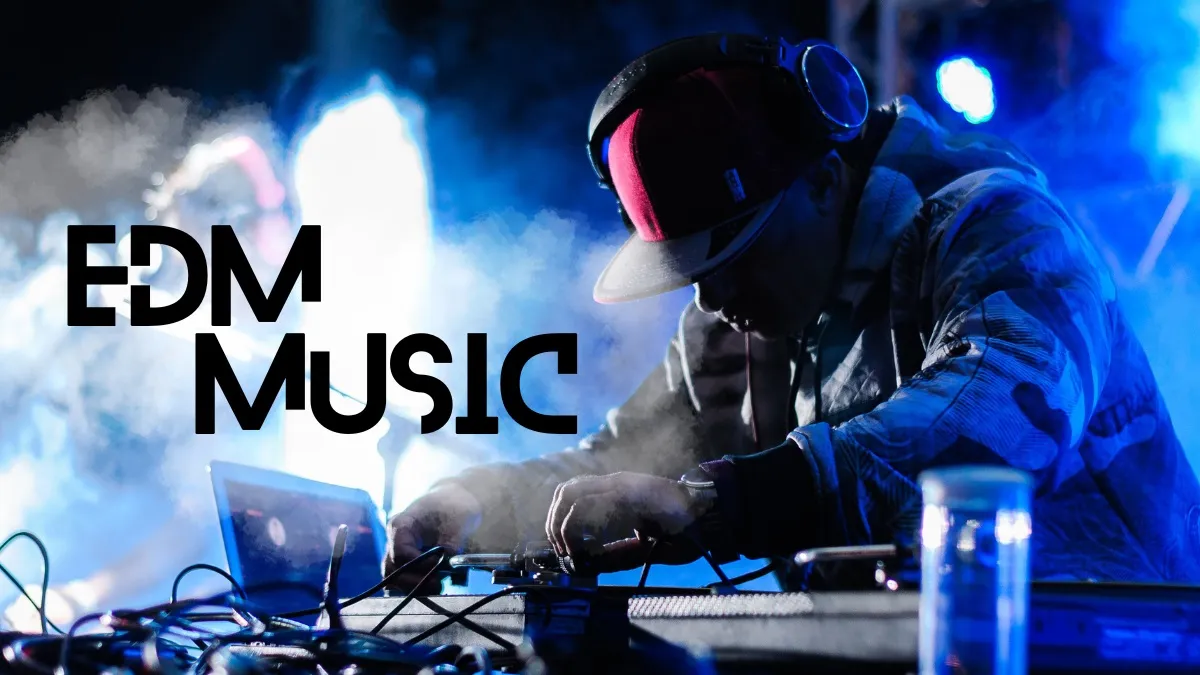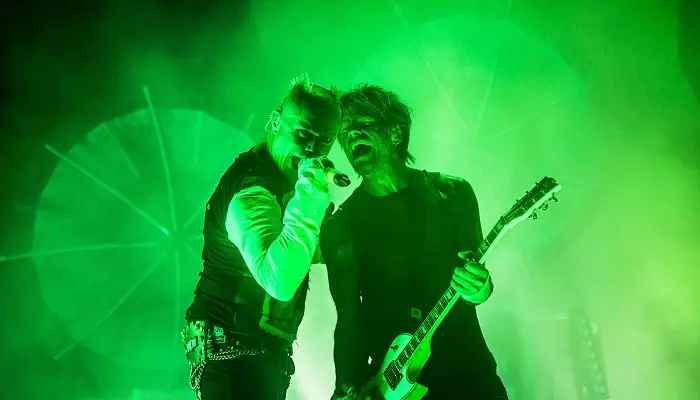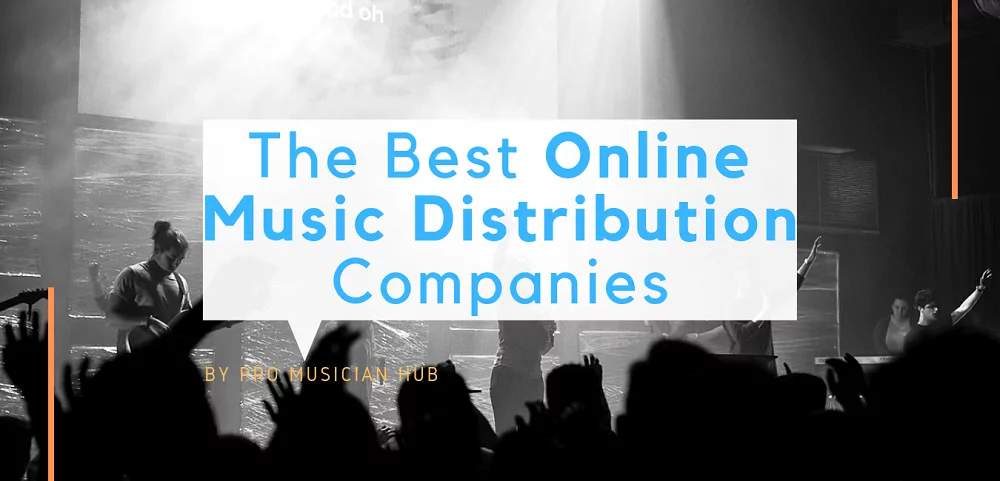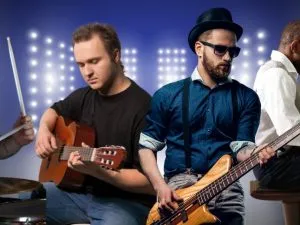If you’re an avid music listener, you’ve surely noticed a surge in the popularity of EDM music over the years.
After all, it’s currently listed as the third most popular genre in the world, just under Hip Hop and Pop/RnB. But why? What is EDM music, exactly, and why is it so popular?
What Is EDM Music?
EDM (Electronic Dance Music), also known as club music, dance music, or simply dance, is an umbrella term used to describe a spectrum of sub-genres that use percussive electronics in their songs.
Most tracks also use a melody that’s generally performed via synthesizer with laid-over drumming.
Brief History of EDM
EDM dates all the way back to the 1960s when bands such as Silver Apples decided to create electronic music specifically made for dancing.
However, the true roots of EDM come in the form of Musique Concrète, a french technique developed by Pierre Schaeffer in 1948.
1940s
Musique Concrète is a type of musical composition wherein artists would modify songs through the use of various audio effects and tape manipulation, effectively creating something similar to a musical collage.
This idea remained a forethought until early synthesizers were created in 1955.
1970s
It was during the 1970s when EDM started rising in popularity, primarily thanks to Giovanni Giorgio Moroder, who’s often dubbed as the “father of electronic dance and synth disco music” and the “father of disco”.
He’s the same man who produced most of Donna Summer’s singles, including ‘I Feel Love‘ and ‘Last Dance‘.
In this era, disco and synth-pop EDM were used to attract crowds to the dancefloor. Artists used the alluring repetitive beat of drum machines and electronic instruments to generate hypnotically synthesized rhythms.
Alongside Donna Summer’s disco hits, some of the most popular disco music that has boosted EDM’s popularity was George McCrae’s ‘Rock Your Baby’ and David Bowie’s ‘Art Decade’.
1980s
When the 1980s came, synthpop was developed, with house music and post-disco electro-music following shortly thereafter.
Technological advancements in the world of audio were quite predominant in the 1980s. Innovations like MIDI and the Roland TR-808 played an important role in the evolution of dance music.
‘Take On Me’ by a-ha along with ‘On and On’ by Jesse Saunders are great popular house records that made a notable impact in EDM.
1990s
The 1990s is said to be the beginning of the powerful era of EDM. This is where popular subgenres such as techno music, house music, dub, trance, hardcore rave, and drum and bass were created.
Since electronic dance music was the craze back then, the inclusion of these new subgenres helped propel newly released songs to mainstream audiences, especially those who lived in Europe.
Acid House became a huge trend in the UK and Germany, with records such as ‘Lack of Love’ and ‘In the Heat of the Night’ topping the charts weekly.
2000s – Present
The early 2000s was a notable time in the EDM genre. International DJs and music producers latched on EDM’s popularity and began releasing multiple EDM albums.
Daft Punk, David Guetta, and Tiësto were huge influences in several EDM subgenres and to this day remain internationally acclaimed EDM musicians.
It was also during this time that dubstep was introduced, primarily thanks to artists like Skrillex and Nero.
Today, multiple EDM subgenres are used by a large majority of pop and hip hop artists, including Justin Bieber, Drake, Katy Perry, and many others.
DJs such as Steve Aoki, The Chainsmokers, and Martin Garrix stay true to the EDM genre and still remain to produce classic EDMs that both young and old enjoy.
The Many Subgenres of EDM
When one claims to love EDM, musicologists usually respond with, “What type of EDM?”
There are currently over 50 genres of EDM available to date. If you’re interested in creating EDM, it’s important to know what genre your track falls in. As follows are some of the most popular subgenres of EDM:
House Music
House music, or simply house, is an EDM sub-genre that’s characterized by a tempo of 120 to 130 bpm (beats per minute) and a repetitive four-on-the-floor beat. It’s well-loved by many due to its warm, positive, “homey” vibe.
This genre usually consists of mid-tempo percussion, jazzy keyboards, shuffling hi-hats, and tropical sounds created by horns, congas, and timbales.
House originated in 1983 in Chicago, Illinois, pioneered by famous producers such as Frankie Knuckles, Ron Hardy, and Jesse Saunders.
This music genre has had a large impact on dance and pop music and still remains to be one of the most popular types of EDM.
Popular house music includes ‘Can You Feel It‘ by Larry Heard (1988), ‘Your Love’ by Frankie Knuckles (2000), and ‘Hey Brother‘ by Avicii (2013).
Deep House Music
Deep house is a combination of Chicago house and jazz-funk. This genre first began in the 1980s, with its origins attributed to Larry Heard’s track ‘Mystery of Love‘.
With tempos ranging from 110 to 125 bpm, deep house music is known for its muted basslines, soft keyboard sounds, ambient mixes, percussion, and soulful predominantly female voices.
The influence of jazz can be heard all throughout deep house music, giving it a slightly dissonant but oddly pleasant feel.
Examples include ‘We Were Younger‘ by Marc Philippe (2018), ‘Don’t Leave Me Now‘ by Lost Frequencies (2020), and ‘How Many Times‘ by Claude VonStroke (2021).
Techno Music
Similar to house, techno music uses a repetitive four on the floor beat and a tempo that varies between 120 and 150 BPM.
Techno artists usually use electronic instruments like synthesizers and sequencers, as well as drum machines and digital audio workstations, to produce a techno vibe.
Due to this, listeners would often describe techno music as ‘cold’ and ‘mechanical’. This is purposely done to achieve a futuristic sound.
Techno subgenres include acid techno, ambient techno, dub techno, industrial techno, minimal techno, and others. Each has its own unique sequences and tune, but it still remains true to the ‘techno’ spirit.
This EDM genre first began in the late 1980s in Detroit, and would slowly travel to parts of Germany. Popular techno music includes ‘Your Mind‘ by Adam Beyer (2018), ‘Bang the Box‘ by Jackmaster (2016), and the well-loved meme, ‘Sandstorm‘ by Darude (2000).
Trance Music
Trance music is a mix between techno and house. It heavily focuses on hypnotic melodies and harmonies that build tension before culminating in one or two drops to achieve a sort of heightened consciousness. It uses a tempo between 135-150 bpm.
This type of EDM first emerged in the early 1990s from the British new-age music scene and the German techno and hardcore scenes. Popular trance music includes ‘You’ll Be OK’ by Gareth Emery (2020) and ‘Save You‘ by Richard Durand (2019).
Trap Music
Trap began in the early 1990s in the Southern United States. This genre is characterized by sounds and lyrics with complicated hi-hat patterns, long decay kick drums, atmospheric synths, and triple time divisions.
The genre gets its name from the word “trap,” an Atlanta slang that refers to a place in which drugs are sold illegally. As such, most trap song lyrics have mentions of drug use or urban violence. Popular trap music includes ‘Ookay‘ by Thief and ‘Threatz‘ by Denzel Curry.
Dubstep
Dubstep is a combination of genres such as broken beat, reggae, techno, dub, and drum and bass. It primarily consists of sparse, syncopated rhythm and percussion patterns with prominent sub-bass frequencies.
This genre gained worldwide recognition when artists such as Britney Spears began using dubstep sounds in her songs from 2009 to 2014.
Later, Sonny John Moore, more famously known as Skrillex, was crowned as the ‘King of Dubstep’ thanks to his songs ‘Scary Monsters and Nice Sprites‘, ‘Bangarang‘, and ‘First of the Year‘.
Industrial Music
Industrial Music is an EDM genre that focuses on transgressive, harsh, or provocative sounds and/or themes. It’s a combination of aggressive rock and electronic metal, alongside avant-garde electronics and punk provocation.
This EDM genre began in the early-to-mid 1970s in countries such as the UK, US, and Germany. During this period, industrial music artists covered controversial topics like sexual perversion, fascism, and the occult.
Psychedelic rock artists Jimi Hendrix and Marilyn Manson, along with Pink Floyd and Frank Zappa, are some of the most influential artists of the industrial music genre.
Drum and Bass
Drum and bass, also written as Drum & Bass or drum’n’bass, is an EDM genre that utilizes heavy bass and sub-bass lines, synths, and samples to create fast breakbeats of 165-185 bpm.
Like most music genres on this list, drum and bass were developed in the early 1990s in the UK. It has a major influence on other EDM genres such as hip-hop, dubstep, house, ambient music, techno, and more.
Initially, major international music labels weren’t interested in the drum and bass scene. It had only consisted of a relatively small group of records, and would often go either unnoticed or ignored.
Drum and bass only rose in popularity when BMG Rights Managements acquired RAM, an independent record label that hosted drum and bass, in February 2018.
Since then, more and more drum and bass albums began to appear in the following years, supported by fan bases across the globe.
Notable drum and bass songs include ‘Rushing Back‘ by Flume ft. Vera Blue (2019) and ‘Breathe In‘ by Technimatic (2019).
Chillout Music
Chillout music, as the name suggests, is characterized by slow tempos and relaxing beats. This genre is often combined with ambient house music along with downtempo, jazz, and classical.
The origins of chillout music aren’t widely known. However, it’s usually identified as a type of modern music genre that began in the early 2000s.
Chillout songs are usually trance-like in nature, typically accompanied by electronic and acoustic instruments. These songs are created for people who prefer to listen to easy and gentle music.
According to the book Dance Music Manual by Rick Snowman, chillout music is created as long as it has a mellow groove and a tempo under 120 bpm.
Some of chillout’s most notable artists include Jjos, Moonbootica, and Paul Kalbrener.
Hardstyle
Hardstyle first emerged in the Netherlands and Belgium in the late 90s. This EDM genre was influenced by techno, new beat, and hardcore music.
It’s typically characterized by hard-sounding and overdriven kick percussion along with offbeat reverse bass, distorted sounds, and synthesizer melodies. Compared to early hardstyle, which was written at 140 bpm, modern hardstyle is much faster at 150 bpm.
This genre of music only gained commercial acceptance in 2010.
In 2018, the world’s biggest hardstyle festival, Defqon.1, was held in the Netherlands. The Defqon.1 featured just under 250 artists across 11 different stages, including the Norweigan hardstyle duo Kenth Kvien and Marcus Nordli in their group ‘Da Tweekaz’.
Electronic Rock
Electronic rock is an EDM genre that combines electronic music with rock elements. It first originated in the late 1960s when rock bands began using synthesizers and electronic percussion in their songs.
This genre incorporates elements from other music styles including industrial rock, techno, and synth-pop, therefore creating sub-genres like dance-punk, electroclash, and indietronica.
Along with synthesizers and electronic percussion, electric rock uses mellotrons, electric guitars, drums, and tape music techniques. Compared to industrial rock, electric rock’s vocals and sounds are either mellow or upbeat. As such, it’s often dubbed progressive rock.
Electronica
Coined in the UK, electronica is created for people who wanted to listen to dance-based electronic music rather than using it for dancing. It originated from techno-pop, hip hop, and electro-funk.
This genre of EDM rose in popularity thanks to Madonna’s album ‘Ray of Light’ and Björk’s ‘Post and Homogenic’. These two artists are said to be responsible for electronica’s exposure to mainstream culture.
Glitch
Glitch is electronic music that’s described to have an “aesthetic of failure” that’s a result of the deliberate use of glitching audio and media.
These glitches often come in the form of audio recording malfunctions, like CD skipping, hardware noise, computer crashes, system errors, and the like. Before advanced technology was created, some audio devices were purposely broken to create said glitching sound.
While officially recognized as a genre in the 1990s, the glitch aesthetic can actually be traced as far back as the 20th century. Tracks such as the 1913 Futurist manifesto, L’arte dei rumori, translated as The Art of Noises, by Luigi Russolo, is one of the most well-known examples of glitch music.
Here, he used mechanical noise generators that he called intonarumori and created other pieces such as The Meeting of Automobiles and Airplanes (Convegno di automobili e aeroplani) and Awakening of a City (Risveglio di una città).
Popular modern glitch artists include GRiZ, David Tipper, The Glitch Mob, and OMFG.
Breakbeat
Breakbeat is a genre of EDM that heavily relies on drum breaks that come from early recordings of R&B, jazz, and funk.
This genre is often used in hip-hop, drum and bass, and jungle. It first appeared in the late 1980s, where it then became an essential feature in a number of genres that use break music.
Tempo breaks usually range anywhere between 110 to 150 bpm, therefore allowing DJs to mix a variety of different genres in their music.
Notable artists that use breakbeat in their music include The Prodigy, Freestylers, and Richie Blacker.
Dissecting an EDM Song: What Makes a Genre EDM?
With all the different EDM genres, it’s often difficult to identify what’s EDM and what’s not. Luckily, you can classify electronic music through three basic elements: four-beat measure, kick or bass drum, and downbeat
All three elements must be created using software known as Digital Audio Workstation (DAW), a MIDI keyboard, and an audio interface. This interface allows users to utilize different effects such as the equalizer, the compressor, auto-tunes, and reverbs and delays.
Two of the most common EDM structures are known as ABABCB and ABCB. This song structure looks like this:
- A – Repeated sections used throughout the song’s verse
- B – Chorus
- C – Bridge
Once you’ve started off your song with a simple four-beat bass drum pattern, you’ll next need to add a high-hat on the upbeat to create a driving motion to your song.
Melodies and other beats can be added using a synth, or you can create them externally and layer them to your song using the same tempo.
The build-up is equally as important as the song’s drop. Here, bass and drums are often used to propel the song forward. Then, when you reach the climax of the song, you need a powerful drop.
So, to reiterate, your song must have an intro, a breakdown, a build-up, and a drop.
With that being said, there’s no ‘right’ or ‘wrong’ when it comes to producing EDM music. Understanding EDM’s basic anatomy will help you create the EDM song you’ve always wanted to produce, so let your creativity shine and follow what you believe sounds best.
















